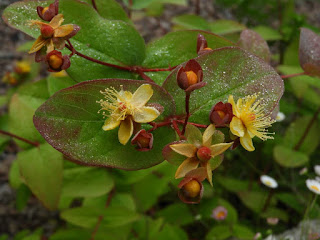Lousewort and Common Cow-wheat grow within a few hundred metres of each other on Beacon Hill near Monmouth. Yellow Rattle can be found in meadows and on local woodland rides.
Lousewort, Pedicularis sylvatica
This grows on the open heathland. Its name suggests a belief that the eating of it gave sheep lice, possibly transmitting them to humans. There is little evidence for this and it may well be a result of it growing on poor grazing land. It also has the names Honeysookies in Shetland, and Honeysuckle in Hampshire. The sweet nectar was enjoyed by children in particular by detaching the blooms and sucking them. (I've come across this tradition a few times so did a bit of research. Before sugar became generally available, and cheap, sweetness was a rare treat: hence the number of plants whose blooms were sucked for nectar.)
The corolla is between 2-2.5 cm long. The bloom is two lipped and pinkish-purple. The upper lip is erect and hooded at the tip with a terminal tooth and single tiny teeth to either side. The lower lip is flat and three lobed.
The flowers are on leafy spikes. It is very low growing and sprawling with intricately cut leaves.
Common Cow-wheat, Melampyrum pratense
This is a woodland plant occurring soon after the open heathland ceases on Beacon Hill. Again a root- hemiparasite it grows in patches running away from the woodland ride. It has dark green spear-shaped leaves and 2-lipped tubular yellow flowers in pairs. Both flowers face the same way at the base of the leaf-like bracts. The upper lip forms a hood, the lower has three small teeth. It is an annual and the seeds are spread by ants which take them back to their nests. Since the ants usually carry them only a few yards the plant is seen as an indicator of ancient woodland.
Folklore tradition suggests it might help with the conception of male children which could have given rise to the name Baby's Rattle in Somerset. The plant is enjoyed by cows and it was thought to produce a better quality butter.
Yellow Rattle, Rhinanthus minor
This plant I saw in a meadow but I have also seen it on woodland rides. It is erect, with yellow flowers. The upper lip is flattened and hooded with two tiny violet teeth on either side of the tip. The lower lip is three lobed. Leaves are stemless, prominently veined with coarse blunt teeth.
The name must come from the sound the seeds make in the inflated calyx that becomes brown and bladder like. On the day I walked through this meadow the rattle was evident, caused by the breeze and my footsteps. (A photobombing insect is allowed for good measure!)
Folk names include Penny-grass in Somerset, Lancashire and Yorkshire, Rattlebags in Devon and Dorset and Fiddle-cases on the Isle of Wight.
Acknowledgements include Harrap's Wild Flowers, Stace 4, Grigson The Englishman's Flora, Richard Mabey Flora Britannica and for the Common Cow-wheat the Plantlife website www.plantlife.org.uk









































